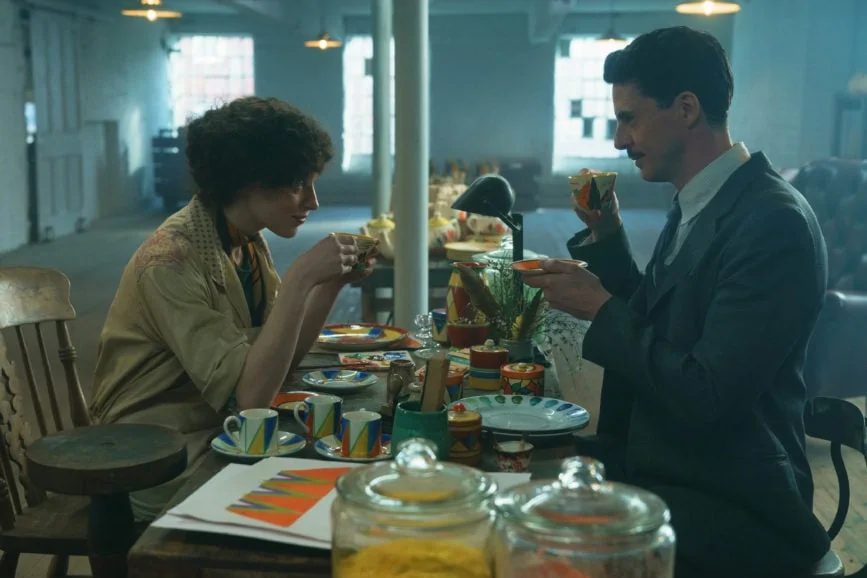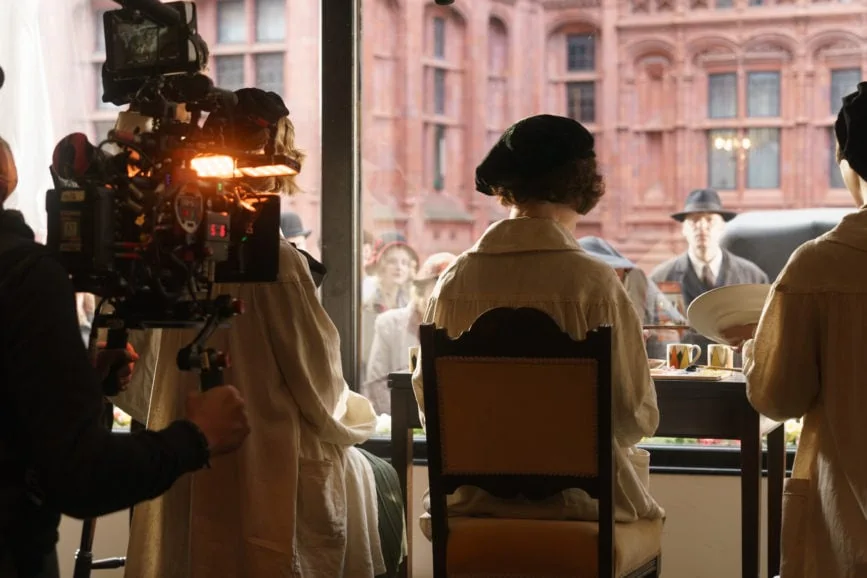A MARRIAGE OF COLOUR
Suddenly, one finds oneself in the early decades of a new century, dealing with economic boom and bust, the lingering effects of pandemic, and the rising clouds of fascism abroad. How do you keep your spirits up?
Well, you can always add a dash of colour to brighten things – maybe even a few dashes. That, certainly, was the response of Clarice Cliff, the renowned 20th century ceramic artist who rose to fame bringing some of the jazz-age zeitgeist of the era – colours, cubism, deco angles, surreal flourishes – to the various potteries she designed for the UK’s home market. Becoming recognised for her non-traditional motifs and ideas, however, remained a challenge in the Stoke-on-Kent of the 1920s, despite eventually having a mentor in the form of Colley Shorter, who co-owned the A.J. Wilkinson potbank with his brother, Guy.
Cliff’s story is told in Sky TV’s The Colour Room. Starring Phoebe Dynevor as the paradigm and palette-changing ceramicist, it was shot by Denson Baker ACS NZCS who was able to join in a week-long rehearsal period with the actors, to start planning camera moves, which needed to be very specific, given the production’s extensive location work.


Baker allowed that being “invited to be part of the (rehearsal) process” was an opportunity other cinematographers might not always have. Benefits include early conversations about how to cover scenes, and work with the emerging blocking, as the actors and director pin down interpretations of character. “Having that opportunity,” he reiterates,“makes such a difference – especially if you want to shoot fast on the day.”
Of course, it also helps when you’re married to the director.
Baker and Claire McCarthy met “at film school when we were just kids,” as Baker recounts. They then went off and “made a film in India together,” which eventually led to both marriage and the formation of their own production company, leaving them, as McCarthy says, “hustling out there, developing projects (and) involving Denson early.” And if Baker benefits by being included in the director’s rehearsal process, McCarthy notes she gets perks not always available on the directing side: Baker is “very generous, and brings me along for tests, with new lenses, when we want to explore the look of a new film.”
Those explorations have steadily borne fruit, with several collaborations, including a recent Australian cinematographer of the Year Milli Award for Baker’s work on the TVNZ/BBC mini-series The Luminaries, based on the novel of the same name, and telling of a prospective prospector settling on New Zealand’s West Coast during its 1860s Gold Rush, made more compelling since this particular adventurer is a she.


This followed in the wake of accolades and awards for McCarthy and Baker’s earlier collaborations, including the feature Ophelia, based on precisely the Shakespearean heroine you think it is.
McCarthy observes that Colour Room’s Midlands setting “was called the Black Country, for a reason,” quoting Arnold Bennett, who grew up in the same region, and would later write about it, and its ever-present smoke, saying “you couldn’t see your hand in front of your face. That struck us as important.”
Especially, in contrast, “with Clarice being a bolt of colour, and optimism in that world. We talked a lot about what the colour could be. We wanted the film to express an emotional colour journey. We got super-nerdy about it and started dissecting colour in every scene.”


Those dissections led to the use of Rotolight Titans, which allowed what Baker describes as a “good programmable fire effect” for the haze-and-kiln-strewn landscape, adding that what he “was really enjoying doing with it (was that) I could adjust the colour in each individual unit – there was a nice bit of colour variation, rather than feeling like it’s a single colour of light. You’ve either got a tungsten colour temp or a daylight colour temp; with a great LED like the Rotolight Titans, I can have nice subtle variations on various areas of the frame.”
Particularly given that “in the 1920s in the Midlands, working class homes were all still oil lamps and candles. When you’re in that period, it’s either warm or cool.” Everything, in other words, defined by sun, hearth, lamp, and candle. But, he continues, “the more I work – the more I light with a subtle shift in frame.”
Those shifts, both in frame, and as the story unfolds, in the public’s taste in potteries, were captured with an ARRI Alexa Mini with vintage Zeiss Super Speed lenses.

In fact, two sets of Super Speeds, one uncoated, which gave “very big blooms, more pronounced than you’d usually get,” in turn augmented with “black glimmer glass and smoke filters as well, which really do catch that light – you do get a prominent bloom.”
Baker was also catching light by doing a lot of his own operating, following the action with an Easyrig. “I do like to do that dance – when the character’s in the moment. I think it’s important for the DP, often making those instinctual camera decisions which you can only do when you’re in the middle of a take. I even find that operating is part of my approach to lighting.”
Being his own operator also helped because the production “had to be quite specific about shooting angles – (though) we weren’t completely locked in and had a little flexibility.”

And having had the rehearsal period, McCarthy says that left them freer to “adapt to ideas that come from blocking, and new ideas the situation presents.”
Besides, it was Cliff herself who famously said, “having a little fun at my work does not make me any less of an artist.”
Though Cliff’s artworks presented another aspect, unique to this production. McCarthy notes they had “over a thousand props of pottery” – original works sourced by collectors. (And) we had not a single thing broken.”











